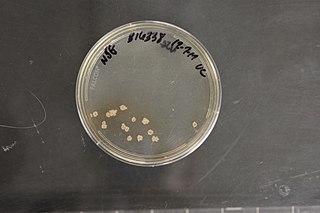
Pseudomonadota is a major phylum of Gram-negative bacteria. The renaming of several prokaryote phyla in 2021, including Pseudomonadota, remains controversial among microbiologists, many of whom continue to use the earlier name Proteobacteria, of long standing in the literature. The phylum Proteobacteria includes a wide variety of pathogenic genera, such as Escherichia, Salmonella, Vibrio, Yersinia, Legionella, and many others. Others are free-living (non-parasitic) and include many of the bacteria responsible for nitrogen fixation.

Micromonosporaceae is a family of bacteria of the class Actinomycetia. They are gram-positive, spore-forming soil organisms that form a true mycelium.

Desulfovibrionales are a taxonomic order of bacteria belonging to the phylum Thermodesulfobacteriota, with four families. They are Gram-negative. The majority are sulfate-reducing, with the exception of Lawsonia and Bilophila. All members of this order are obligately anaerobic. Most species are mesophilic, but some are moderate thermophiles.
The International Code of Nomenclature of Prokaryotes (ICNP) or Prokaryotic Code, formerly the International Code of Nomenclature of Bacteria (ICNB) or Bacteriological Code (BC), governs the scientific names for Bacteria and Archaea. It denotes the rules for naming taxa of bacteria, according to their relative rank. As such it is one of the nomenclature codes of biology.
Rubrobacter is a genus of Actinomycetota. It is radiotolerant and may rival Deinococcus radiodurans in this regard.

Acidilobales are an order of archaea in the class Thermoprotei.
Methanobacteriales is an order of archaeans in the class Methanobacteria. Species within this order differ from other methanogens in that they can use fewer catabolic substrates and have distinct morphological characteristics, lipid compositions, and RNA sequences. Their cell walls are composed of pseudomurein. Most species are Gram-positive with rod-shaped bodies and some can form long filaments. Most of them use formate to reduce carbon dioxide, but those of the genus Methanosphaera use hydrogen to reduce methanol to methane.
In taxonomy, the Methanococcales are an order of the Methanococci.
In the taxonomy of microorganisms, the Methanomicrobiales are an order of the Methanomicrobia. Methanomicrobiales are strictly carbon dioxide reducing methanogens, using hydrogen or formate as the reducing agent. As seen from the phylogenetic tree based on 'The All-Species Living Tree' Project the family Methanomicrobiaceae is highly polyphyletic within the Methanomicrobiales.

Sulfolobales is an order of archaeans in the class Thermoprotei.
In taxonomy, the Ferroplasmaceae are a family of the Thermoplasmatales.
Sphingobacteriaceae is a family of environmental bacteria.
Methanogenium is a genus of archaeans in the family Methanomicrobiaceae. The type species is Methanogenium cariaci.
In taxonomy, Methanococcoides is a genus of the Methanosarcinaceae.
In taxonomy, Methanolobus is a genus of methanogenic archaea within the Methanosarcinaceae. These organisms are strictly anaerobes and live exclusively through the production of methane, but the species within Methanolobus cannot use carbon dioxide with hydrogen, acetate or formate, only methyl compounds. The cells are irregular coccoid in form and approximately 1 μm in diameter. They do not form endospores. They are Gram negative and only some are motile, via a single flagellum. They are found in lake and ocean sediments that lack oxygen.

Haloarcula is a genus of extreme halophilic Archaea in the class of Halobactaria.
Halorhabdus is a genus of halophilic archaea in the Haloarculaceae. With an extremely high salinity optimum of 27% NaCl, Halorhabdus has one of the highest reported salinity optima of any living organism.
In taxonomy, Halosimplex is a genus of the Halobacteriaceae.
Methanocalculus is a genus of the Methanomicrobiales, and is known to include methanogens.

The Glycomycetaceae are a family of bacteria.







